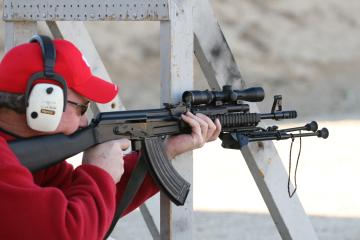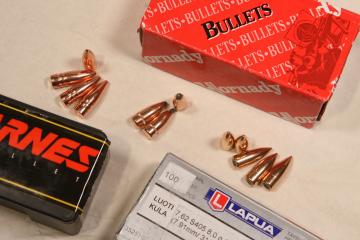
 With an optic to replace the AK's terrible iron sights, this shooter
engages targets out to 425 yards; his ammunition needs to be accurate
enough to get the job done.
With these characteristics in mind, 7.62x39 is a good platform for
launching medium and heavy .30 caliber projectiles at a somewhat
sedate velocity. The standard loading of a 123-grain bullet at 2330
fps represents what I believe ought to be the lower end of bullet mass
used with 7.62x39. In this bullet-weight class, terminal performance
can be improved simply with the use of better bullets.
Unlike virtually all other "7.62" or .30 caliber cartridges, the
Russian 7.62x39 uses a non-standard bullet diameter: .310 inch instead
of .30. Thus most "Western" .30 caliber or .308 bullets will not work
in the 7.62x39. This is slowly changing as a a few bullet makers have
come forth with modern bullets specifically for the 7.62x39.
The most interesting is the 123-grain Barnes TSX-BT. Barnes' TSX
bullets are made from solid copper; they do not have a conventional
jacket and core. The TSX bullet has a solid shank, and then a
hollow-point nose. When the bullet impacts tissue, the hollow point
expands to create a wide wound channel while the solid bottom shank
stays solid for excellent penetration. The TSX-BT bullet has a
boat-tail to incrementally aid the BC value. Barnes TSX bullets have
yielded impressive results on game from .22 caliber up to .33
caliber.
Standard lead-tipped hunting bullets such as the Hornady 123-grain SP
will produce predictable results on game. Lapua has a 123-grain FMJ
bullet that ought to produce terminal results about the same as the
mil-spec FMJ. Standard construction hollow-point bullets will produce
more violent expansion and fragmentation, usually at the expense of
overall penetration. Cor-Bon's 125-gr JHP and the Wolf "Military
Classic" JHP both will provide increased terminal performance over
standard FMJ. The Wolf JHP shows fragmentation in ballistic gelatin.

 Regular .30 caliber bullets are not proper for 7.62x39; Barnes,
Hornady, and Lapua are three manufacturers with bullets specifically
for the Russian cartridge.
Here are potential untapped strengths of the 7.62x39. First, because
of the relatively small powder volume versus bore size, relatively
little performance is lost as barrel length is reduced. This makes
the 7.62x39 a perfect candidate for very short carbines. For example,
a load that replicates M43 using Accurate #1680 powder will lose only
about 70 fps when barrel length is reduced from 16 inches to 14
inches. Going down to a 12-inch barrel only loses another 83 fps,
while a 10.5 inch barrel will still fire the 123-grain bullet at just
over 2100 fps. The 7.62x39 is an ideal cartridge for a short-barreled
rifle, provided a bullet that produces good terminal ballistics is
used.
The second untapped strength of 7.62x39 is the use of heavier bullets.
Although the vast majority of loads use a 120 to 125-grain bullet, a
150-grain bullet - the mainstay of .308 Winchester loads - can be
fired at 2100 to 2200 fps from a 16-inch barrel. Going further, a 175
to 180-grain bullet can be fired at 1900 to 2000 fps. As bullet mass
is increased, the ability for impressive penetration and terminal
effects improves. These heavy bullets will lose even less velocity as
barrel length is reduced. For example, a 180 grain load may lose only
100 fps as the barrel length is reduced from 16 to 12 inches.
|